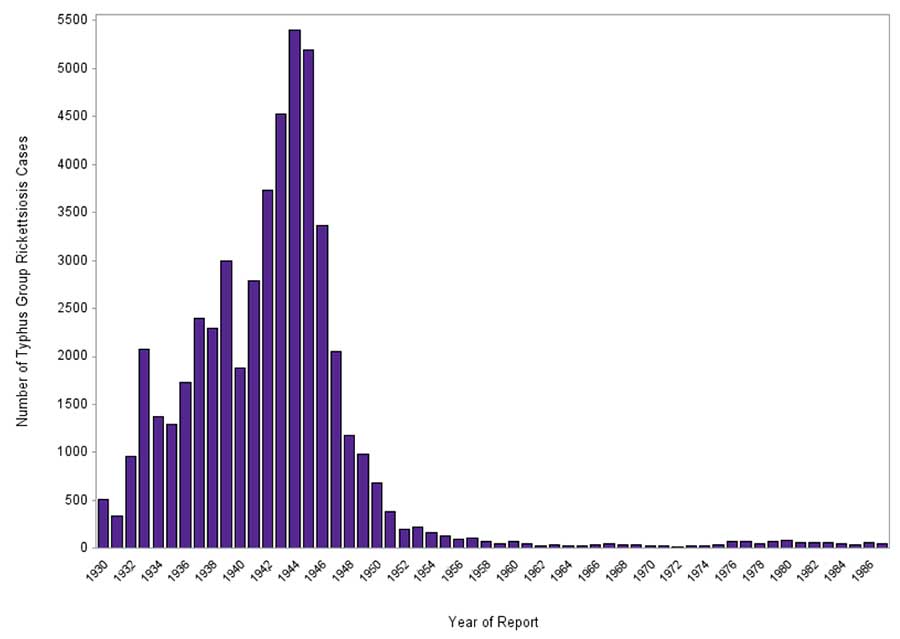Historical trends
- Flea-borne (murine) typhus was a nationally notifiable disease from 1930 until 1987.
- During 1930 through the 1940s, thousands of cases of flea-borne typhus were reported annually. Beginning in the 1950s, cases of flea-borne typhus began to decline drastically, in part due to widespread advances in sanitation and pest management. By 1958, less than a hundred cases were reported each year.
- Because of the rarity of the disease, in 1987, the Council of State and Territorial Epidemiologists voted to remove flea-borne typhus from the list of nationally notifiable diseases.
- Flea-borne typhus cases still occur in certain areas of the country, including California, Hawaii, and Texas.
- Reporting is still required in some states and local jurisdictions. Check with your state or local health departments to learn if flea-borne typhus is reportable in your state and, if applicable, what the current case counts are in your area.
Number of Annual Typhus Group Rickettsiosis Cases, 1930-1987

| Year | Number of Cases |
|---|---|
| 1930 | 511 |
| 1931 | 333 |
| 1932 | 956 |
| 1933 | 2,070 |
| 1934 | 1,375 |
| 1935 | 1,287 |
| 1936 | 1,733 |
| 1937 | 2,394 |
| 1938 | 2,294 |
| 1939 | 2,996 |
| 1940 | 1,878 |
| 1941 | 2,784 |
| 1942 | 3,736 |
| 1943 | 4,528 |
| 1944 | 5,401 |
| 1945 | 5,193 |
| 1946 | 3,365 |
| 1947 | 2,050 |
| 1948 | 1,174 |
| 1949 | 985 |
| 1950 | 685 |
| 1951 | 378 |
| 1952 | 205 |
| 1953 | 221 |
| 1954 | 163 |
| 1955 | 135 |
| 1956 | 98 |
| 1957 | 113 |
| 1958 | 71 |
| 1959 | 51 |
| 1960 | 68 |
| 1961 | 46 |
| 1962 | 32 |
| 1963 | 35 |
| 1964 | 30 |
| 1965 | 28 |
| 1966 | 33 |
| 1967 | 52 |
| 1968 | 36 |
| 1969 | 36 |
| 1970 | 27 |
| 1971 | 23 |
| 1972 | 18 |
| 1973 | 32 |
| 1974 | 26 |
| 1975 | 41 |
| 1976 | 69 |
| 1977 | 75 |
| 1978 | 46 |
| 1979 | 69 |
| 1980 | 81 |
| 1981 | 61 |
| 1982 | 58 |
| 1983 | 62 |
| 1984 | 53 |
| 1985 | 37 |
| 1986 | 67 |
| 1987 | 49 |
Page last reviewed: July 11, 2019